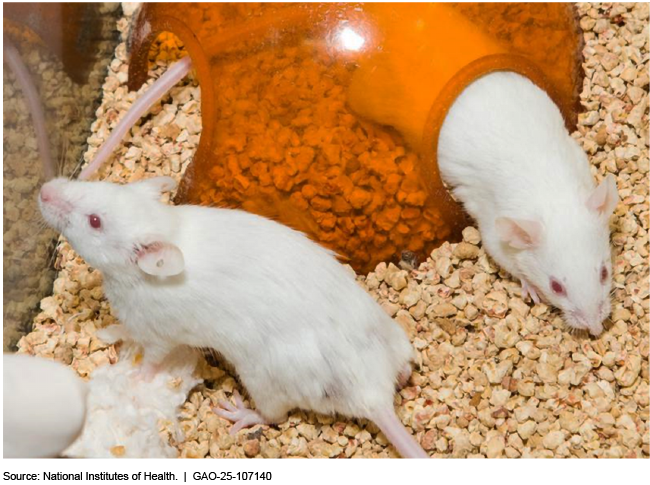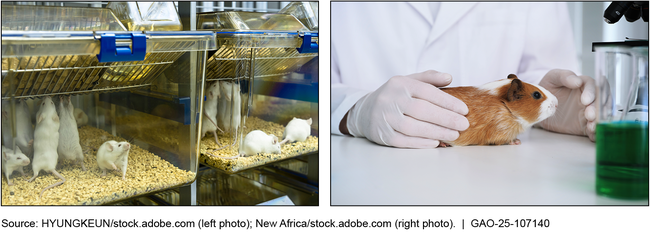National Institutes of Health: Assessing Efforts to Improve Animal Research Could Lead to Greater Human Health Benefits
Fast Facts
Research using animals can lead to a better understanding of human health and treatments for diseases.
To achieve these advancements, it is important for research results to be replicated and shown to apply to humans. However, this is challenging to do.
The National Institutes of Health has taken steps to address the challenges in research it conducts or supports. But it hasn't fully followed best practices for assessing the effectiveness of its efforts. Our recommendations address this.
NIH also takes steps to ensure the welfare of animals used in research. For example, it requires NIH-funded institutions to report animal mistreatment.

Highlights
What GAO Found
Research involving animals has contributed to a better understanding of human health and new treatments for diseases; for example, it has helped scientists to develop a COVID vaccine. However, concerns have been raised about the welfare of laboratory animals. The National Institutes of Health (NIH) has a policy that addresses the welfare of animals in research conducted by its institutes and external institutions. NIH takes various steps to oversee this research. These include requiring institutions to report and address noncompliance with the policy at the institutional and project levels and monitoring compliance with the policy.
Examples of Types of Animals Used in Animal Research

Concerns have also been raised about whether the results of animal research can consistently be reproduced in subsequent animal studies (reproducibility) or translated into similar results for humans (translatability). Multiple challenges contribute to reported low success rates in reproducibility and translatability, according to NIH, scientific publications, and scientific researchers GAO interviewed. For example, researchers sometimes do not publish enough details about their study design and use of animals. As a result, other researchers attempting to reproduce the research may obtain different or inconsistent results. Also, animals' responses to experimental treatments and drugs do not necessarily resemble those of humans because of inherent biological differences.
NIH has taken steps to enhance the reproducibility and translatability of animal research it conducts and supports. For example, NIH issued a policy in 2015 on enhancing reproducibility through rigor and transparency, issued guidelines, and provided resources for researchers. However, NIH has not fully implemented key practices that can help agencies assess whether their efforts have led to measurable improvements. For example, NIH has not defined short-term goals to help track progress toward improving reproducibility and translatability or collected evidence that would help the agency assess the effectiveness of its efforts. Such evidence could include agency-wide information on whether grant applicants are following its 2015 policy. Agency officials said they had not done so because variability among different fields of study would require setting field-specific goals and measures. However, GAO has reported that, in cases like this, agencies can set specific targets and time frames for different areas and assess the contributions of each area to an agency's long-term goals.
Why GAO Did This Study
NIH, within the Department of Health and Human Services, spends about $5.5 billion annually to support animal research. NIH supports research conducted by its own institutes and by external entities such as universities. In recent years, researchers have reported low success rates in reproducing and translating the results of animal experiments. Reproducibility of a study can reflect how reliable its results are, and translatability enables animal research to benefit human health.
The Consolidated Appropriations Act, 2023 includes a provision for GAO to report on aspects of animal welfare, reproducibility, and translatability in research NIH conducts or supports. This report addresses (1) steps NIH takes to ensure animal welfare in research it conducts and supports, (2) challenges that limit the reproducibility and translatability of this research, and (3) steps NIH has taken to enhance reproducibility and translatability in animal research.
GAO analyzed NIH documents and data; reviewed relevant scientific publications; conducted two site visits to labs that conduct animal research; and interviewed NIH officials, scientific researchers, and representatives of nongovernmental organizations.
Recommendations
GAO is making two recommendations to NIH to define short-term goals and collect evidence to assess its efforts to enhance the reproducibility and translatability of animal research. The agency concurred with both recommendations.
Recommendations for Executive Action
| Agency Affected | Recommendation | Status |
|---|---|---|
| National Institutes of Health | The Director of NIH should define short-term goals with measurable targets and time frames related to enhancing reproducibility and translatability in animal research that the agency conducts and supports. For example, some initial goals could include targets for the number of NIH-funded publications that report certain factors that affect reproducibility and translatability, such as randomization and appropriate sample sizes. (Recommendation 1) |
The agency agreed with this recommendation. We will update the status of the recommendation when we receive additional information.
|
| National Institutes of Health | The Director of NIH should collect evidence needed to assess NIH's efforts to enhance reproducibility and translatability in animal research. This could include steps such as (1) analyzing attempts to reproduce NIH-funded studies or (2) collecting information from projects that attempt to reproduce significant lines of research. (Recommendation 2) |
The agency agreed with this recommendation. We will update the status of the recommendation when we receive additional information.
|
